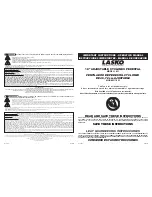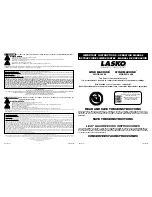
REPAIR & REPLACEMENT
W A R N I N G
- 6 -
Fan should only be serviced by qualified
personnel with HVAC equipment
experience.
Disconnect fan from power supply before
servicing fan. Lock the switch in the “OFF”
(open) position and/or tag the switch to
prevent unexpected power application.
1. After repairing any component:
a. Check that electrical connections are correct and
secure.
b. Remove any foreign material from enclosures.
c. Install and secure all covers.
d. Ensure that all fasteners are tight.
e. Remove all foreign objects from fan.
f. Ensure air exits through dampers and fan rotates
counterclockwise when viewed from rear of fan
(see Figure 8).
MOTOR, FAN, AND
FAN GUARD
1. Remove the (8) screws and washers that are holding the fan
grills to the shroud (see Figure 9).
2. Remove the (4) bolts and nuts that are holding the motor to
the motor mount (see Figure 10).
3. Remove the motor, fan and grills from the frame by lifting the
motor (see Figure 11).
4. Before removing the fan, measure and record the location of
the fan hub on the motor shaft (see Figure 12). If fan is difficult
to remove, use a gear puller on the fan hub.
5. To reassemble, place grills with grill clips onto motor (see
Figure 12) then position fan on motor shaft and tighten set
screws.
6. Place motor assembly onto motor mount and fasten the fan
guard to cabinet.
7. Center fan in shroud opening. Leave approximately 1/16” to
3/16” (1.6 to 4.8mm) gap between the motor and fan guard.
(see Figure 13).
8. Bolt motor to motor mount. Manually spin the fan blade to
ensure it rotates freely before applying power.
9. Air must exit through dampers and fan must rotate counter
clockwise when viewing from the rear of the fan
(see Figure 9).
FIGURE 11
FIGURE 8
Fan
rotation
Mounting Holes
(on top and bottom)
Air
Intake
Support back
of motor
FIGURE 12
Fan Locking
Bolt
FIGURE 10
FIGURE 9
Motor Bolts
(2 on each side)
Grill Screws (8)
1/16” to 3/16”
(1.6 to 4.8 mm)
FIGURE 13






























